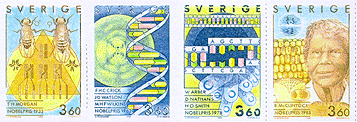One x 10 ml "bulk culture"
Inoculate with ~ 103 bacteria @
Grow for g = 17 generations
Plate entire "individual cultures"
& 200 ul aliquots of "bulk culture" on petri dish w/ T1
"The first experiment was done on
the following Sunday morning.
(In a letter dated January 21 [1943], Delbruck exhorted me to
go to church"
Twenty
x 200 ul "individual cultures"
One x 10 ml "bulk culture"
Inoculate with ~ 103 bacteria
@
Grow for g = 17 generations
![]() ~108
bacteria / ml
~108
bacteria / ml
Plate entire
"individual cultures"
& 200 ul aliquots of "bulk culture" on petri dish w/
T1
| Bulk Cultures |
Individual Cultures |
|
| Experiment ## |
10a |
16 |
|
|
16.7 |
|
|
|
15 |
|
| Variance (smc) |
18.2 |
752.1 |
Single bulk culture (e.g., Experiment
10a):
Ten replicates samples of same culture
a
= n / N = (16.7 / (0.2 ml x 108 bacteria / ml) = 8 x 10-7 variants
/ cell
variance
~ mean ![]() random
distribution
random
distribution
Expected result for either induced or
spontaneous hypotheses: a control
Multiple individual cultures (e.g.,
Experiment 16):
mean ~ mean in bulk
variance
>> variance in bulk:
Experiment
supports
Mutation
Hypothesis !
Calculation of Mutation rate (a)
mean # mutations /
culture = aN
Poisson predicts
null class = p0 = exp(-
a/N)
where
p0 = fraction of cultures with no
Tonr mutants
Rewrite as a = - ln (p0 /
N )
p0 = 11 / 20 =
0.55 from Experiment 16
N = 0.2 ml x 108 bacteria / ml
Then a = -ln 0.55 / (0.2 x 108)
= 3 x 10-8 mutations / cell / generation
 January 24, 1943
Salvador Max |
"The MS of the theory arrived on February 3rd ...."
Luria on significance of
experiments:
(1) "Adequate evidence" of spontaneous
mutation as source of genetic variation
(2) Provided method for
measuring mutation rates,
and therefore is
(3) "The
Birth of Molecular Genetics"
bacteria
can be used to measure extremely low gene mutation rates
Homework:
repeat above calculations for Experiments 3 & 21a